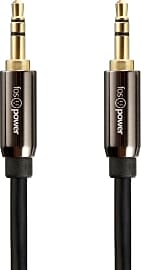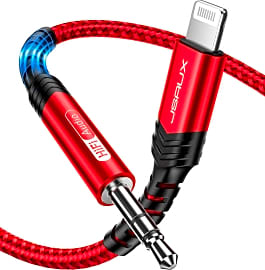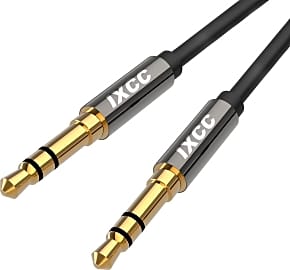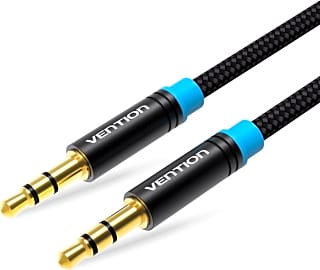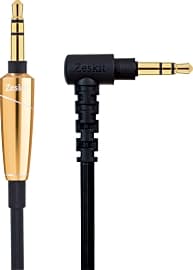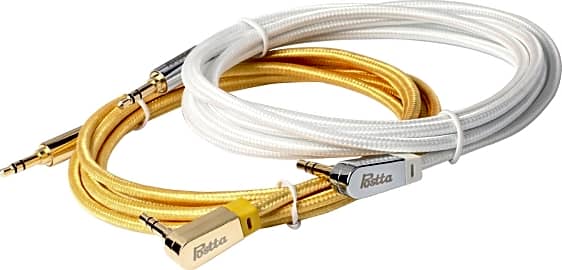The 10 Best Aux Cables

This wiki has been updated 38 times since it was first published in April of 2015. With some notable exceptions, the majority of portable devices that are capable of playing music have auxiliary outputs to enable them to be connected easily to a car or home stereo system, portable speakers, and more. Our selection of aux cables features a variety of lengths and materials, including some high-end cords that will let you amplify your tunes without losing sound quality. When users buy our independently chosen editorial picks, we may earn commissions to help fund the Wiki.
Editor's Notes
January 26, 2021:
Though there isn't a lot of innovation from year to year in auxiliary cables, we did need to make a couple of changes to our recommendations during this update. The most notable is the removal of the Belkin MixIt, as it is simply to prone to breakage when pulled a little too hard. In its place we added JSAux Lightning because there was a distinct lack of options compatible with iPhones. We also generally put preference on models that were reinforced at the point where the cable connects to the plug housing, as this is a common point of failure on these types of cables.
January 07, 2020:
While many people just assume that all auxiliary cables are exactly the same, nothing could be further from the truth. Not only does the material and construction of the inner components matter, but so too does the exterior jacket. For example, braided options like the UGreen 10605, Vention 10018, and Postta JST-36 tend to be the most tangle-resistant. And, if the exterior braid is made from nylon, as in the case of the UGreen 10605 and Vention 10018, they are usually going to be extremely durable. However, the downside to models with a braided jacket is that they tend to be thicker, which makes them harder to wrap up and slip into a pocket when not in use.
Of course, there are some non-braided options, like the Zeskit AUC-SP12 or iXCC Universal, which are also designed to be tangle resistant. In the case of the iXCC Universal, this is accomplished by using a low-friction material, while the jacket of the Zeskit AUC-SP12 boasts a sawtooth design to help reduce the friction that causes tangling.
When it comes to interior components, you'll want to look for a pure copper wire, such as can be found in the UGreen 10605, KabelDirekt Pro Series, Vention 10018, and many others on this list. Ideally, auxiliary cables should also have two layers of shielding to help prevent electromagnetic or radio frequency interference, such as can be seen in the FosPower FOSCBL, Mediabridge MPC-35, and UGreen 10605. Gold-plated connectors are also desirable as they won't corrode like other metals. Of all the models on our list, the Belkin MixIt is the only one that doesn't feature gold-plated connectors, but we felt the right-angle design of one of its plugs and the flat jacket still make it a worthy option to include.
If you plan on using your auxiliary cable with a thick phone case, it is important to choose a model like the Anker Premium, FosPower FOSCBL, iXCC Universal, KabelDirekt Pro Series, Mediabridge MPC-35, Zeskit AUC-SP12, and Postta JST-36, all of which feature a step-down design.
A Brief History Of The Auxiliary Cable
The small size of the connector, along with its single-plug simplicity, made it ideal for widespread adoption.
The basic phone connector used in auxiliary cables can trace its roots all the way back to 1878, when the quarter inch connector was designed for use by switchboard operators in manual telephone exchanges. Later, the two-conductor 3.5 millimeter and 2.5 millimeter versions were developed as smaller alternatives to the bulky quarter inch cable, and were widely used to connect transistor radio earpieces. Sony used the 3.5 millimeter jack in radios as early as 1964, but the connector became even more prevalent with the advent of the famed Walkman in 1979.
Before long, the 3.5 millimeter jack had become an almost universal analog audio connector as personal electronics and portable audio equipment became increasingly popular. The small size of the connector, along with its single-plug simplicity, made it ideal for widespread adoption. Today, the 3.5 millimeter plug is used with almost all pedestrian devices that feature an audio output, including digital cameras, smartphones, computers, microphones, and other similar devices. One device in particular, of course, shifted the paradigm of how we interface with music and other audio content.
In the early years of the 21st Century, the advent of the iPod -- and the concurrent prevalence of other MP3 players -- forever altered the relationship between music and the listener. Physical storage formats such as the compact disc quickly became obsolete as people everywhere opted to use these new, highly efficient devices. Even the early MP3 players could store hundreds or even thousands of digital songs on a device that fit in the palm of the hand, bringing an unparalleled easy of portability and accessibility to music and other audio files for the first time. The success of the MP3 player had effects on other types of hardware, too, as aux cables became the bridge between personal audio libraries and the world at large, connecting to speakers, cars, computers, and so much more.
A Closer Look At The Aux Cable
When researching aux cables, you'll quickly learn that auxiliary is hardly a term of art: these cables go by many names.
When researching aux cables, you'll quickly learn that auxiliary is hardly a term of art: these cables go by many names.
Aux cables are typically male-to-male cables with a 3.5 millimeter connector—designed to fit into a standard headphone and/or microphone port— on either one or both ends. These connectors are actually technically a type of phone jack but, to make the matter slightly more confusing, one can also call them stereo minijacks, headphone jacks, phone plugs, mini stereo-jacks, or any combination of these words.
The technical term for the type of connector used on the aux cable is a TRS connector. The letters of the acronym stand for "tip," "ring," and "sleeve," respectively. The cables are used to transmit analog audio signals via these components. The tip is the metallic end of the plug, while the sleeve is usually a ground and describes the long metal sheath at the base of the connector. The ring describes the metallic section that encircles the plug. (TS connectors lack a ring, so they have two conductors and are suitable for unbalanced connections.)
As noted, most aux cables are male-to-male cables with matching 3.5 millimeter connectors, also known as stereo minijack connectors. But while usually they feature the same plug on both ends, some options are also available with a range of more specialized connectors on one side. For example, if the aux cable will be used with a receiver, you may want to choose a 3.5 millimeter stereo minijack to RCA cable to accommodate your receiver's available inputs.
Choosing The Right Aux Cable For Your Needs
If you are simply looking to connect your iPhone (or Samsung Galaxy, or iPod, or an old CD player or Walkman, for that matter) to your car's auxiliary input port, you will find it quite simple to buy a suitable aux cable at a very affordable price.
As you have likely discerned, auxiliary cables are quite affordable.
If, however, you are selecting cables to be used in a professional recording studio or an editing bay, and you need to make sure you have a reliable connection between your devices and plenty of excess cord to move the units around the space, you should expect to spend a little more. As you have likely discerned, auxiliary cables are quite affordable. Even an aux cable with a 24k gold plated connector a cord made from braided copper that has aluminum shielding and polyethylene insulation is priced in range for anyone.
Choosing the right aux cable is, therefore, less about budget, and more about cord length and, odd as it may seem, appearance. Choosing a cable of the right length should be easy enough; just measure the distance your device sits from the port to which it must connect. An aux cable's appearance is another matter: as many auxiliary cables are actually rather prominent, hanging from your car's dashboard or trailing down from your ears to your pocket, for example, looks do matter.



